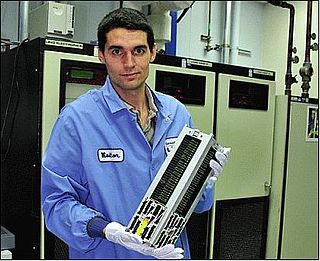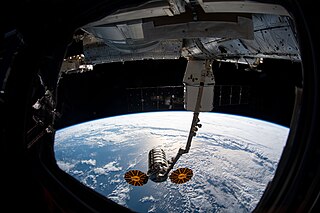AMSAT is a name for amateur radio satellite organizations worldwide, but in particular the Radio Amateur Satellite Corporation (AMSAT) with headquarters at Washington, D.C. AMSAT organizations design, build, arrange launches for, and then operate (command) satellites carrying amateur radio payloads, including the OSCAR series of satellites. Other informally affiliated national organizations exist, such as AMSAT Germany (AMSAT-DL) and AMSAT Japan (JAMSAT).

A CubeSat is a class of miniaturized satellite based around a form factor consisting of 10 cm (3.9 in) cubes. CubeSats have a mass of no more than 2 kg (4.4 lb) per unit, and often use commercial off-the-shelf (COTS) components for their electronics and structure. CubeSats are put into orbit by deployers on the International Space Station, or launched as secondary payloads on a launch vehicle. As of August 2021, more than 1,600 CubeSats have been launched.

A small satellite, miniaturized satellite, or smallsat is a satellite of low mass and size, usually under 1,200 kg (2,600 lb). While all such satellites can be referred to as "small", different classifications are used to categorize them based on mass. Satellites can be built small to reduce the large economic cost of launch vehicles and the costs associated with construction. Miniature satellites, especially in large numbers, may be more useful than fewer, larger ones for some purposes – for example, gathering of scientific data and radio relay. Technical challenges in the construction of small satellites may include the lack of sufficient power storage or of room for a propulsion system.

Radio Aurora Explorer (RAX) is the first National Science Foundation sponsored CubeSat mission. The RAX mission is a joint effort between SRI International in Menlo Park, California and the University of Michigan in Ann Arbor, Michigan. The chief scientist at SRI International, Dr. Hasan Bahcivan, led his team at SRI to develop the payload while the chief engineer, Dr. James Cutler, led a team of students to develop the satellite bus in the Michigan Exploration Laboratory. There are currently two satellites in the RAX mission.

The NASA Launch Services Program (LSP) is responsible for procurement of launch services for NASA uncrewed missions and oversight of launch integration and launch preparation activity, providing added quality and mission assurance to meet program objectives. LSP operates under the NASA Space Operations Mission Directorate (SOMD).

KickSat was a satellite dispenser for small-satellite (femtosatellite) project inaugurated in early October 2011, to launch many very small satellites from a 3U CubeSat. The satellites have been characterized as being the size of a large postage stamp. and also as "cracker size". The mission launch was originally scheduled for late 2013 and was launched April 18, 2014.
Technology Education Satellite (TechEdSat) is a successful nano-sat flight series conducted from the NASA Ames Research Center in collaboration with numerous universities. While one of the principal aims has been to introduce young professionals and university students to the practical realm of developing space flight hardware, considerable innovations have been introduced. In addition, this evolving flight platform has tested concepts for Low Earth Orbit (LEO) sample return, as well as planetary nano-sat class mission concepts.

Nanoracks LLC is a private in-space services company which builds space hardware and in-space repurposing tools. The company also facilitates experiments and launches of CubeSats to Low Earth Orbit.

Orbital-3, also known as Orb-3, was an attempted flight of Cygnus, an automated cargo spacecraft developed by United States-based company Orbital Sciences, on 28 October 2014. The mission was intended to launch at 22:22:38 UTC that evening. This flight, which would have been its fourth to the International Space Station and the fifth of an Antares launch vehicle, resulted in the Antares rocket exploding seconds after liftoff.

Planet Labs PBC is an American public Earth imaging company based in San Francisco, California. Their goal is to image the entirety of the Earth daily to monitor changes and pinpoint trends.

The Nanoracks CubeSat Deployer (NRCSD) is a device to deploy CubeSats into orbit from the International Space Station (ISS).

Mars Cube One was a Mars flyby mission launched on 5 May 2018 alongside NASA's InSight Mars lander. It consisted of two nanospacecraft, MarCO-A and MarCO-B, that provided real-time communications to Earth for InSight during its entry, descent, and landing (EDL) on 26 November 2018 - when InSight was out of line of sight from the Earth. Both spacecraft were 6U CubeSats designed to test miniaturized communications and navigation technologies. These were the first CubeSats to operate beyond Earth orbit, and aside from telecommunications they also tested CubeSats' endurance in deep space. On 5 February 2019, NASA reported that both the CubeSats had gone silent by 5 January 2019, and are unlikely to be heard from again. In August 2019, the CubeSats were honored for their role in the successful landing of the InSight lander on Mars.

NG-11, previously known as OA-11, is the twelfth flight of the Northrop Grumman robotic resupply spacecraft Cygnus and its eleventh flight to the International Space Station under the Commercial Resupply Services (CRS-1) contract with NASA. The mission launched on 17 April 2019 at 20:46:07 UTC. This is the last mission from the extended CRS-1 contract; follow-up missions are part of the CRS-2 contract. Cygnus NG-11 was also the first mission to load critical hardware onto Cygnus within the last 24 hours prior to launch, a new Antares feature.
The University of Georgia Small Satellite Research Laboratory (SSRL), or UGA SSRL, is a research laboratory founded in late 2015 with the goal of launching a student-built spacecraft into low Earth orbit. The SSRL is currently building the University of Georgia's first two satellites. The lab has a Space Act Agreement with the NASA Ames Research Center.

ArgoMoon is a CubeSat that was launched into a heliocentric orbit on Artemis 1, the maiden flight of the Space Launch System, on 16 November 2022 at 06:47:44 UTC. The objective of the ArgoMoon spacecraft is to take detailed images of the Interim Cryogenic Propulsion Stage following Orion separation, an operation that will demonstrate the ability of a cubesat to conduct precise proximity maneuvers in deep space.

Note: As of the school year of 2022, the Irvine CubeSat STEM Program has been shut down. The Irvine Public School Foundation (IPSF) has reallocated the CubeSat funding elsewhere and Brent Freeze has left the project to pursue other endeavors. This change could have resulted from the lack of productivity during the COVID-19 pandemic and the loss of talented students. It is rumored that the program could return during the 2023 school year.
Irvine CubeSat STEM Program (ICSP) is a joint educational endeavor to teach, train and inspire the next generation of STEM professionals. ICSP involves students from six high schools from Irvine, California, and its main objective is to assemble, test, and launch a CubeSat into low Earth orbit.
EQUULEUS is a nanosatellite of the 6U CubeSat format that will measure the distribution of plasma that surrounds the Earth (plasmasphere) to help scientists understand the radiation environment in that region. It will also demonstrate low-thrust trajectory control techniques, such as multiple lunar flybys, within the Earth-Moon region using water steam as propellant. The spacecraft was designed and developed jointly by the Japan Aerospace Exploration Agency (JAXA) and the University of Tokyo.

Simulation-to-Flight 1 (STF-1) is a microsatellite built by the Katherine Johnson Independent Verification and Validation Facility (IV&V) in Fairmont, West Virginia with the collaboration of the West Virginia Space Grants Consortium and West Virginia University.
















